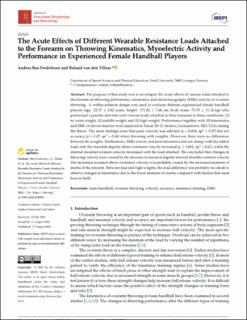| dc.contributor.author | Fredriksen, Andrea Bao | |
| dc.contributor.author | van den Tillaar, Roland Johannes Wilhelmus | |
| dc.date.accessioned | 2023-02-09T14:08:09Z | |
| dc.date.available | 2023-02-09T14:08:09Z | |
| dc.date.created | 2022-10-12T14:56:34Z | |
| dc.date.issued | 2022 | |
| dc.identifier.citation | Fredriksen, A. B. & van den Tillaar, R. (2022). The acute effects of different wearable resistance loads attached to the forearm on throwing kinematics, myoelectric activity and performance in experienced female handball players. Journal of Functional Morphology and Kinesiology, 7(3), Article 58. doi: | en_US |
| dc.identifier.issn | 2411-5142 | |
| dc.identifier.uri | https://hdl.handle.net/11250/3049807 | |
| dc.description.abstract | The purpose of this study was to investigate the acute effects of various loads attached to the forearm on throwing performance, kinematics and electromyography (EMG) activity in overarm throwing. A within-subjects design was used to evaluate thirteen experienced female handball players (age: 22.15 ± 2.82 years; height: 171.62 ± 7.68 cm; body mass: 73.35 ± 11.16 kg) who performed a penalty shot test with various loads attached to their forearms in three conditions: (1) no extra weight, (2) middle weight and (3) high weight. Performance together with 3D kinematics and EMG of eleven muscles were analyzed in Visual 3D (C-motion, Germantown, MD, USA) during the throw. The main findings were that peak velocity was affected (p = 0.004, ηp2 = 0.37) but not accuracy (p = 0.47, ηp2 = 0.06) when throwing with weights. However, there were no differences between the weights. Furthermore, EMG activity and most kinematics did not change with the added load; only the maximal angular elbow extension velocity increased (p ≤ 0.001, ηp2 = 0.67), while the internal shoulder rotation velocity decreased with the load attached. We concluded that changes in throwing velocity were caused by the decrease in maximal angular internal shoulder rotation velocity. The increased maximal elbow extension velocity was probably caused by the increased moment of inertia of the forearm. Between mid and high weights, the load difference was probably too small to observe changes in kinematics due to the lower moment of inertia compared with studies that used heavier balls. | en_US |
| dc.language.iso | eng | en_US |
| dc.publisher | MDPI | en_US |
| dc.rights | Navngivelse 4.0 Internasjonal | * |
| dc.rights.uri | http://creativecommons.org/licenses/by/4.0/deed.no | * |
| dc.title | The acute effects of different wearable resistance loads attached to the forearm on throwing kinematics, myoelectric activity and performance in experienced female handball players | en_US |
| dc.type | Peer reviewed | en_US |
| dc.type | Journal article | en_US |
| dc.description.version | publishedVersion | en_US |
| dc.rights.holder | © 2022 The Authors | en_US |
| dc.source.pagenumber | 10 | en_US |
| dc.source.volume | 7 | en_US |
| dc.source.journal | Journal of Functional Morphology and Kinesiology | en_US |
| dc.source.issue | 3 | en_US |
| dc.identifier.doi | 10.3390/jfmk7030058 | |
| dc.identifier.cristin | 2060888 | |
| dc.source.articlenumber | 58 | en_US |

